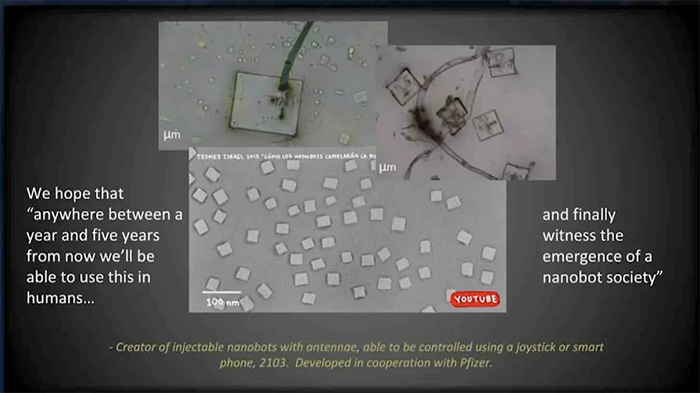
The Omniwar Symposium was well worth watching in full. It hits many points I’ve been covering for years now, from transhuman ambition to religious inversion. Even so, there was plenty of new material for me to sink my teeth into. All the presenters are admirably learned and articulate, so the info went down easy.
Their overarching thesis posits an all-encompassing assault by elite powers on mass populations—the fat cats against “the people.” This is a global war, waged alongside various inter-elite geopolitical conflicts. In the long view, the omniwar is a struggle to establish a technocratic hegemony. It is a fight to crush our freedoms. It is a war against humanity.
By and large, this accusation is a response to the traumatic Covid measures brought down on the citizens of nearly every nation on earth. I may disagree with the symposium’s ultimate conclusions—especially those godforsaken nanobots—but they’ll get no argument from me about the 2020 terror campaign. In America, people in most states saw their rights trampled upon. Corporations and the federal government forced vaccination under penalty of unemployment. Lives were upended. Family ties were broken. It was a crime against human dignity.
Those were treacherous times. Without future safeguards, they’re likely to be repeated ad nauseam. One key component of resistance, though, will be to attack the system with precision, and not allow ourselves to get lost in puerile fantasies.
The symposium included my friend Patrick Wood, who has taught me a great deal about technocracy and transhumanism. His presentation was characteristically lucid, from the early history of the technocracy movement at Columbia University to its continued relevance in our present era. “Technocracy is the science of social engineering,” Patrick quoted from a 1937 issue of The Technocrat, “the scientific operation of the entire social mechanism to produce and distribute goods and services to the entire population.”
The Covid crackdown was nothing if not technocratic in essence. Governments used “the numbers” to lock down their citizens and neutralize their justified protests. Drug corporations hid the real numbers to deny their customers’ vaccine injuries. Both colluded to form impromptu biosecurity states. These people should all burn in hell—at least for a little while.

Despite the normie-con temptation to attribute everything to “Marxism” (which is sort of like Jew obsession, minus the nepotism and alleged moneylust), Patrick drew a clear distinction between technocracy and communism. “Marxists hated technocracy with a passion,” he explained, “and for good reason: technocrats would push man out of the picture altogether, resulting in a hierarchy of scientific dictatorship run by scientists and engineers.”
That insight doesn’t play well with TV-brained Fox News fans, but I appreciate the nuance. “Technocracy wanted to do away with all political systems,” Patrick went on, “including communism and socialism.”
Similarly, while acknowledging that most technocrats and transhumanists begin from atheistic premises—viewing the organic world as a system of interlocking mechanisms—Patrick emphasized that not all atheists are technocrats or transhumanists. Such distinctions will be critical going forward, lest we come off like torch-bearing witch-hunters.

As it happens, a recent paper by one Omniwar participant, Daniel Broudy, inspired me to resume my research into nano-scale technology. The idea is that the Covid jabs—and perhaps chemtrails streaking overhead—contain sophisticated nanobots which can be activated by 5G routers to monitor or manipulate a subject’s body and brain. Some say these self-assembling vaxxbots can kill a man like tiny ball-busting pagers floating through his bloodstream. Click… BOOM!
I remain unconvinced.
In fact, an expert commentary hastily published by the same outlet as Broudy’s paper—the International Journal of Vaccine Practice, Theory, and Research—flatly states there are “No Nanobots in Vaccines — Just Lipids on the Loose.” But in sensationalist vaxxbot circles, the psychological damage has already been done and the clickbait money already extracted.
Broudy avoided all mention of the nanos during his Omniwar presentation, leaving that to his co-authors Lissa Johnson and David Hughes. Instead, he focused on the broader sociological implications of technocracy. The presentation was well-written, and he read it from his screen with eloquence. His main point was that our leaders treat us like cattle, using surveillance and mind control to herd the masses at will.
My regular readers will know I agree with that up to a point. But a one-dimensional characterization misses two vital elements. First off, anyone who’s carefully studied the transhumanist literature knows that “liberty” and “morphological freedom” are key principles that complicate any top-down oppression narrative.
Second, and just as important, is the dark reality that—much like large-scale technocratic institutions treat mass populations like cattle—many business savvy “freedom fighters” have captured the imaginations of smaller sub-populations, filled their heads with sci-fi delusions, and made off with their minds (and money) like web-crawling cattle-rustlers.
Speaking about large-scale control systems, though, Broudy did include one quote from Bertrand Russell’s essay “Scientific Technique in an Oligarchy” that really captures the menace of our age. In his original passage, Russell highlights the “evils” of Soviet Russia and the “atrocities” of the Nazis, looking ahead to the more insidious possibilities of scientific totalitarianism. For whatever reason, Broudy omits Russell’s obvious disdain for communism, fascism, and dictatorship, but his excerpt is relevant nonetheless.
“Diet, injections, and injunctions will combine,” Russell wrote in 1951, “to produce the sort of character and the sort of beliefs that the authorities consider desirable, and any serious criticism of the powers that be will become psychologically impossible. Even if all are miserable, all will believe themselves happy, because the government will tell them that they are so.”
Broudy pairs this quote with the 2016 slogan “You’ll own nothing and be happy,” which, to Broudy’s credit, he traces not to Klaus Schwab—as is fashionable—but rather to its original source. Even so, Broudy’s presentation had the effect of flattening the problems of our era to some World Economic Forum-centered conspiracy. If only life were so simple.

Lissa Johnson gave the most compelling talk, describing “transhumanism as a military-intelligence operation with Covid-19 as a supporting psychological operation.” Her literature review of military, government, and corporate documents was superb. She cited a number of white papers I’d never seen before, so I’ve been following her trail for several days now. This new information has been illuminating, and for that I’m grateful.
In fact, I highly recommend you listen to her talk in full. If that piques your interest, do read the four-part series that Johnson co-authored with Daniel Broudy and David Hughes. The information they marshal is of great interest, although I suspect their literalist, overly imaginative conclusions will do more harm than good. That’s for you to decide. (Well, you and objective reality, if anyone can grasp such a thing.)
Two themes from Johnson’s presentation really hit me: the “manipulation of reality perception” and the recurring dreams (and nightmares) of advanced nanotechnology. It’s true that, by their very nature, psychological operations are methods of perceptual manipulation. It’s also true that advanced nanotech transmitters—whether administered via injection or aerosol—are a long-standing goal of both military and medical authorities. Yet there’s an ironic connection between these two notions that Johnson seems to miss.

If, as Johnson, Broudy, and Hughes suggest, the human race is presently being seeded with self-assembling nano-scale circuitry or full-blown nanobots—whether injected into arms or dropped from fake clouds—then we live in a nightmare world of invisible creepy crawlies. These are basically UFOs in your bloodstream: unidentified floating objects. They can’t stop Covid, apparently, but they can monitor your vital signs and control your mind.
On the other hand, if such nanotech still remains in a fantasy realm alongside quantum computers and artificial superintelligence—both of which attract billions in funding, with little more than neat parlor tricks to show for it—then Johnson et al. are leading people to chase invisible Easter Bunnies down a rabbit hole to nowhere.
Whether they mean to or not, they also discredit any real resistance to governmental technocracy and corporate transhumanism by activating delusional loud-mouths.
“Don’t ya’ll worry about no mRNAs in them shots. It’s the nanner bots that’ll get’che!!”
Indeed, if viable, mass-deployed nanobots do not yet exist, then vaxxbot alarmism is itself a psy op. It’s a “manipulation of reality perception” that convinces dupes to believe their vaxxed friends and family are 5G-controlled zombies, or that airborne nanos are falling from the sky like demonic snowflakes. In that case, the evil vaxxbot is part of a “simulated reality” that rips people’s minds apart.
Johnson et al. do a great job of showing intent, though. No one can deny that well-heeled scientists and government agents want to use nanotech to cure illness—and to deploy nanos as weaponry. This is hardly a secret. You can find bold statements of intent everywhere, from best-selling books to YouTube videos posted by the would-be perpetrators themselves.
It’s far more difficult to prove that secret agents are deploying invisible nanotech right now. Johnson primes the pump with her more articulate version the oft-repeated mantra: “Top secret tech is decades ahead of anything we see today!!” To support this notion, she cites the former head of NASA’s Langley Research Center, Dennis Bushnell, whose infamous 2001 slideshow “Future Strategic Issues/Future Warfare [Circa 2025]” has been making the rounds for many years.

Johnson goes through a list of exotic technologies—genetic engineering of human beings, implantable electronics, nanobots, smart dust, biocomputing, artificial life, etc. She then interprets a vague bullet point on Bushnell’s slide as meaning “such technologies remain in inventory for over forty years” so they were “no pixie dust” back in 2001. If I understand Johnson correctly, she’s saying classified technology is already forty years into the Future™!
To support this mythos, Johnson cites the Harvard science historian Peter Galison, who once argued that “classified scientific research is five to ten times larger than what we see in the open literature.” That wildly imprecise estimate seems overblown to me, but for the sake of argument, let’s assume this is true.
Why should we assume this galaxy of classified R&D has produced a slew of viable technologies? Think of it this way:
Two primary objectives of nanotech are to cure disease and reverse aging. If our clandestine agencies have nanos that are decades ahead of what we see today, why are Ray Kurzweil and Klaus Schwab deteriorating before our eyes? Wouldn’t they be among the first to get a neurological nano-boost, or at least a cellular face-lift?
Have their minds been uploaded to a secret metaverse for the elite, leaving their senile husks to babble onstage?
As a thought experiment, let’s imagine Bushnell’s speculative NASA slideshow contains literal descriptions of existent tech in 2001—actual “‘Bots and ‘Borgs” and “wonderous/ubiquitous land/sea/air/space multiphysics/hyperspectral sensor swarms.”
Okay then, why are two astronauts still stranded on the International Space Station? And why are windows blowing out of Boeing aircraft? Are NASA and Boeing pretending to be incompetent so no one looks for their secret moon base?
I’m serious.
To be fair, Johnson does confront the question: “Where is the tangible R&D?” However, her evidence is just another series of quotes from think tank employees and military propagandists who talk about all the great stuff they’re doing—i.e., justifying their paychecks. Johnson then cites a handful of well-funded nanotech projects. Allow me to put forward a counterpoint: so far, these people have wasted a lot of money for next to nothing in return.
Johnson presents exactly zero evidence that labs have produced self-assembling nano-scale circuitry or nanobots that are ready to be deployed on a dozen people in the wild—let alone half the world’s population. Even worse, she goes on to show us crudely rendered cartoons of proposed biodigital networks as evidence of mature technologies. She concludes by defending certain “scientists” who claim to find vaxxbots under their microscope lenses (which, again, was sternly rebutted here).
“It’s not pixie dust,” Johnson insists. Indeed, I’m more inclined to believe pixie dust actually exists.

Johnson and Broudy’s co-author, David Hughes, won me over at first during his Omniwar presentation. He and I share an appreciation of the satanist-hunting schizoid, Vigilant Citizen, whose dot-connecting analysis of mass entertainment amused me for many years—at least until VC went behind an esoteric paywall. Even if our metaphysics differ, I thought to myself, Hughes and I would probably have much to discuss over a couple of pints.
Then, as if to taunt me, Hughes went on to proudly endorse the harebrained theory that the World Trade Center towers were brought down by “directed free-energy technology”—a.k.a. space lasers. With a calm and confident British accent, Hughes suggested our “elite rulers” are lying about “finite resources” on earth so they can exert “global centralized control.”
“What happens, then, if all of that is a founding myth? What happens if there is such a thing as free-energy technology?” Hughes asks skeptically. “What happens if there actually is the possibility of limitless abundance in the world? These are the things that people need to know about, because it really exposes the foundation of the control system.”
Good questions. Allow me to pose another. What happens when the Skeptoid Ouroboros leads an otherwise sharp individual to abandon centuries of scientific research in favor of unlimited oil and magic “pixie dust” technology?
Is the ultimate objective for “the people” to get their hands on this “free-energy technology” so we can, I dunno, inject ourselves with life-extension serum or build space communes on Mars?
Look, I’m gonna let you in on a dark secret of the cosmos: most people will believe anything. That includes a belief in absurd technologies, whether benevolent or malevolent. A person’s high IQ is no protection from that tendency. In fact, due to the ample mental space a big brain provides, it’s oftentimes a handicap.

To paraphrase Mork: “Nano, nano.”
I humbly suggest that Johnson, Broudy, and Hughes look up from their stacks of white papers for a moment and think about what they’re saying. If top secret projects really are “twenty years ahead of anything we see today,” there would be an unknown continent where flying cars buzz around AI-controlled cities running on cold fusion generators. Maybe scientists there are using time machines to bring back dinosaurs for the local zoo.
No one can prove a negative. So I cannot prove that ubiquitously deployed nanobots don’t exist. Nor can I prove that viable flying cars (not those wobbly mini-copters) and sustainable cold fusion are only pipedreams clogging up the patent office. It’s a big world out there. What do I know?
But after five hours of listening to the Omniwar Symposium, I’m less convinced of vaccine- or chemtrail-borne nanos than when I began. Instead, I’m even more convinced that internet-borne memes can attach themselves to a person’s brain and detach his or her consciousness from objective reality.
I am not arguing that the vaxxbot theories floated by Johnson, Broudy, and Hughes are untrue. I am saying I don’t believe them. Their source material is of great value and I commend their research efforts. But their aggressive conclusions are unconvincing.
As for my readers, I encourage you to listen to this trio, to read their papers carefully, and draw your own conclusions. By now you know I have no intention of telling you what to believe. Not that it would matter if I did. If there’s one thing I’ve learned over the past few years, it’s that people will believe whatever they like.
Subscribe the Bombthrower mailing list to get these pieces as they drop, you’ll also receive a free copy of The Crypto Capitalist Manifesto.
Sign up for Joe Allen’s Singularity Weekly here.


"In the long view, the omniwar is a struggle to establish a technocratic hegemony."
Any elites are going to be technocratic to some degree (by definition, any successful elite controls everything worth controlling, and tech is of course worth controlling). The mistake many people start making is that just because the elites are terrible, tech is terrible. Obviously not all tech is terrible. It's important to distinguish between tech that terrible elites love, and tech that common people can use for their own benefit.
"By and large, this accusation is a response to the traumatic Covid measures brought down on the citizens of nearly every nation on earth."
If you reached the conclusion that elites are terrible during the pandemic, you reached that conclusion way too late and got your ideas way too mixed up. The elites are terrible, deadly viruses are terrible, that doesn't mean that the elites and deadly viruses have much in common, beyond the fact that the elites will avoid deadly viruses while being quite happy for common people to catch them. The problem was never the vaccine, the problem was that the elites are quite willing to make a big fuss about the vaccine if that will deflect attention from how willing they are to abuse common people in all sorts of ways that have nothing to do with vaccines. And boy, do they have the money and the Big Data to deflect attention successfully. Remember, rich=evil with such a degree of precision these days that you should not bother looking to any other details when judging any rich person. Hate them all. God will sort out the few innocents among them.